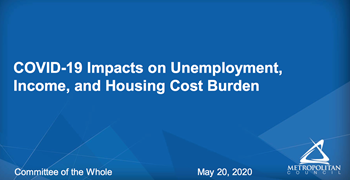COVID-19 Impacts on Unemployment, Income, and Housing Cost Burden

Metropolitan Council Research designed a scenario analysis of how the Twin Cities region's workforce and households are impacted by the current economic crisis. We sought to answer: What impacts will job losses have on households' incomes? How much will federal responses mitigate the economic pain?
Our analytic approach was to summarize job loss rates from the national, monthly Current Population Survey and link these to an American Community Survey microdata sample for the Twin Cities region. We then build scenarios for the Twin Cities region: We apply national field-specific job loss rates to Twin Cities region sample; subtract estimated lost employment and lost earnings; and calculate new outcomes for workers and households, for varying lengths of economic "shutdown," with and without the federal relief response.
Results of the analysis include resulting employment, incomes and income change, poverty rates, and housing cost burden rates for each demographic group. All of these results are tabulated by occupation and industry sector, by race, by housing tenure, and by pre-crisis income quintile.
See the slides from the May 20, 2020 presentation to the Committee of the Whole (PDF)